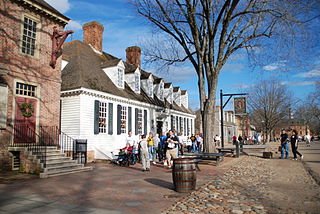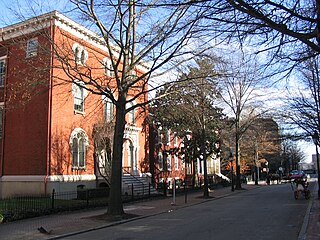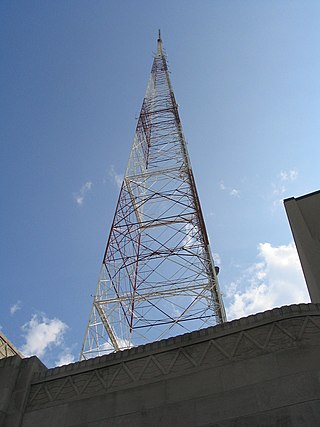Related Research Articles

Colonial Williamsburg is a living-history museum and private foundation presenting a part of the historic district in the city of Williamsburg, Virginia. Its 301-acre (122 ha) historic area includes several hundred restored or recreated buildings from the 18th century, when the city was the capital of the Colony of Virginia; 17th-century, 19th-century, and Colonial Revival structures; and more recent reconstructions. The historic area includes three main thoroughfares and their connecting side streets that attempt to suggest the atmosphere and the circumstances of 18th-century Americans. Costumed employees work and dress as people did in the era, sometimes using colonial grammar and diction.
Church Hill, also known as the St. John's Church Historic District, is an Old and Historic District in Richmond, Virginia. This district encompasses the original land plat of the city of Richmond. Church Hill is the eastern terminus of Broad Street, a major east-west thoroughfare in the Richmond metropolitan area. The name Church Hill is often used to describe both the specific historic district and the larger general area in the East End encompassing other neighborhoods such as Union Hill, Chimborazo, Fairmount, Peter Paul, Woodville, etc.

Oregon Hill is a historic working-class neighborhood in Richmond, Virginia. Oregon Hill overlooks the James River and Belle Isle, and provides access to Hollywood Cemetery. Due to the neighborhood's proximity to the Monroe Park Campus of Virginia Commonwealth University, the neighborhood is sometimes referred to as a student quarter because of its high college student population.
The Greater Richmond, Virginia area has many neighborhoods and districts.
Founded in 1889, the Association for the Preservation of Virginia Antiquities was the United States' first statewide historic preservation group. In 2003 the organization adopted the new name APVA Preservation Virginia to reflect a broader focus on statewide Preservation and in 2009 it shortened its name to Preservation Virginia. Preservation Virginia owns historic sites across Virginia including Historic Jamestowne, located at Jamestown, Virginia, site of the first permanent English settlement in North America, and the Cape Henry Light house, one of the first public works projects of the United States of America.

The Poe Museum or the Edgar Allan Poe Museum, is a museum located in the Shockoe Bottom neighborhood of Richmond, Virginia, United States, dedicated to American writer Edgar Allan Poe. Though Poe never lived in the building, it serves to commemorate his time living in Richmond. The museum holds one of the world's largest collections of original manuscripts, letters, first editions, memorabilia and personal belongings. The museum also provides an overview of early 19th century Richmond, where Poe lived and worked. The museum features the life and career of Poe by documenting his accomplishments with pictures, relics, and verse, and focusing on his many years in Richmond.

Thomas Salem Bocock was a Confederate politician and lawyer from Virginia. After serving as an antebellum United States Congressman, he was the speaker of the Confederate States House of Representatives during most of the American Civil War.

Jackson Ward, previously known as Central Wards, is a historically African-American district in Richmond, Virginia, with a long tradition of African-American businesses. It is located less than a mile from the Virginia State Capitol, sitting to the west of Court End and north of Broad Street. It was listed as a National Historic Landmark District in 1978. "Jackson Ward" was originally the name of the area's political district within the city, or ward, from 1871 to 1905, yet has remained in use long after losing its original meaning.

Court End is a neighborhood in Richmond, Virginia, that sits to the north of the Capitol Square and East Broad Street. It developed in the Federal era, after Virginia's capital moved from Williamsburg.

Clifton A. Hall (1826-1913) was an American architect from Providence, Rhode Island.

The Richmond Theatre fire occurred in Richmond, Virginia, United States, on Thursday, December 26, 1811. It devastated the Richmond Theatre, located on the north side of Broad Street between what is now Twelfth and College Streets. The fire killed 72 people, including Virginia's governor George William Smith, former U.S. senator Abraham B. Venable, and other government officials in what was the worst urban disaster in U.S. history at the time. The Monumental Church was erected on the site as a memorial to the fire.

St. Andrew's School is a tuition-free school focused on the whole child. It is fully accredited by the Virginia Association of Independent Schools (VAIS). Richmond philanthropist and social reformer Grace Arents founded the school in 1894. It is located in the historic Oregon Hill neighborhood. The school includes grades K-5 with a total of 96 students.
Elisabeth Scott Bocock was an American patron of the arts. Known for her philanthropy and historic preservation, she was active in founding a number of organizations in Richmond, Virginia.

Scott House, also known as Frederic W. Scott House and Scott-Bocock House, is a historic home located in Richmond, Virginia and is owned by Virginia Commonwealth University as the University's alumni house. The first floor of the historic house is available for university, community and corporate events. Many affairs — including university and alumni receptions and retreats — have occurred at the Scott House since its doors opened in the fall of 2004.

The Scott's Addition Historic District is a national historic district located in Richmond, Virginia.

Libby Hill is a small neighborhood in Richmond, Virginia. Libby Hill is located on the southeastern spur of Church Hill, overlooking the James River and the Lucky Strike building. It is known for Libby Hill Park and "The View that Named Richmond". The Libby Hill neighborhood is entirely within the St. John's Church Historic District.
John Granderson Zemmer Jr. (1942–2016) was an architectural historian, preservationist, photographer, and author of architectural history in Virginia and North Carolina, especially in Richmond, Virginia. His work includes documentation and an impressive catalog of photographs of historic properties. He produced several books on historic sites and is credited with helping preserve several buildings.
The African American Cultural Heritage Action Fund is a program formed in 2017 to aid stewards of Black cultural sites throughout the nation in preserving both physical landmarks, their material collections and associated narratives. It was organized under the auspices of the National Trust for Historic Preservation. The initiative which awards grants to select applicants and advocates of Black history has been led by architectural historian Brent Leggs since 2019. It is the largest program in America to preserve places associated with Black history.

Mary Wingfield Scott (1895–1983) was an American historic preservationist who documented Richmond, Virginia neighborhoods and advocated for preservation over demolition.
References
- ↑ Richmond Times Dispatch, Elisabeth Scott Bocock Obituary, Article date December 12, 1985
- ↑ Historic Richmond Foundation, Mission and History Page
- ↑ Hitz, Mary Buford. Never Ask Permission: Elizabeth Scott Bocock of Richmond, p. 57